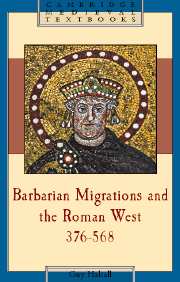Book contents
- Frontmatter
- Contents
- List of maps and figure
- Acknowledgements
- A note on spellings
- Part I Romans and barbarians in the imperial world
- Part II A world renegotiated: Western Europe, 376–550
- 6 The Gothic crisis, 376–382
- 7 The crisis of the Empire, 382–410
- 8 The triumph of the generals, 410–455
- 9 The parting of Gaul and Italy, 455–480
- 10 Kingdoms of the Empire, 476–550
- 11 Provincial society in the long fifth century
- 12 Beyond the old frontier
- Part III Romans and barbarians in a post-imperial world
- Appendix: Gildas' narrative and the identity of the ‘proud tyrant’
- Bibliography
- Index
- Key to map 3 on page 75
- Cambridge Medieval Textbooks
7 - The crisis of the Empire, 382–410
Published online by Cambridge University Press: 05 June 2012
- Frontmatter
- Contents
- List of maps and figure
- Acknowledgements
- A note on spellings
- Part I Romans and barbarians in the imperial world
- Part II A world renegotiated: Western Europe, 376–550
- 6 The Gothic crisis, 376–382
- 7 The crisis of the Empire, 382–410
- 8 The triumph of the generals, 410–455
- 9 The parting of Gaul and Italy, 455–480
- 10 Kingdoms of the Empire, 476–550
- 11 Provincial society in the long fifth century
- 12 Beyond the old frontier
- Part III Romans and barbarians in a post-imperial world
- Appendix: Gildas' narrative and the identity of the ‘proud tyrant’
- Bibliography
- Index
- Key to map 3 on page 75
- Cambridge Medieval Textbooks
Summary
THE USURPATIONS OF MAGNUS MAXIMUS AND EUGENIUS AND THE DEATH OF THEODOSIUS, 383–395
In 383 things went wrong for Emperor Gratian. The British army raised one of its commanders to the purple, a Spaniard called Magnus Maximus. Maximus crossed to Gaul and confronted Gratian at Paris. Abandoned by his troops, the emperor was killed, by a ruse, at Lyon (25 August). The reasons for the break-up of Gratian's regime are unclear. The emperor had not been unsuccessful, winning military laurels against the Alamanni and playing his part in suppressing the Gothic revolt. He married his half-sister to Theodosius, evidently aware that the division of the Empire only worked when family links united the emperors. Gratian's management of imperial patronage seems to have been at stake, perhaps unsurprising given that at his death he was still only twenty-three. Contemporaries wrote that Gratian was intelligent and possessed many qualities but had never been taught how to rule, or shown himself willing to learn. What this meant in practice might be illustrated by Gratian's showing undue preference to Alan troops, presumably raised from barbarians defeated during the Gothic crisis, thus alienating his regulars. In the north-west, where the revolt broke out, unrest might have been caused by his increasingly frequent residence in Italy. In 380 the western court moved to Milan and the influence of the Gallic faction based around Gratian's tutor Ausonius appears to have ended. The importance of imperial presence in Gaul has been mentioned.
- Type
- Chapter
- Information
- Barbarian Migrations and the Roman West, 376–568 , pp. 186 - 219Publisher: Cambridge University PressPrint publication year: 2007



